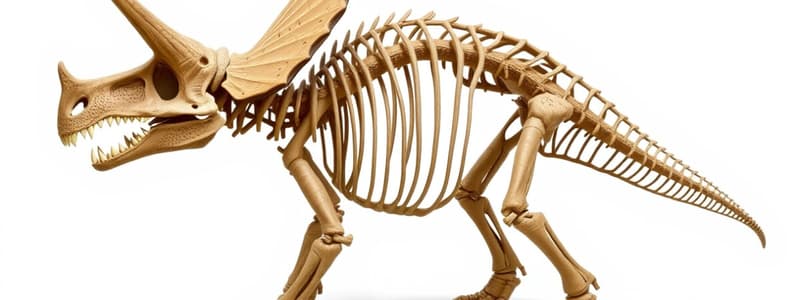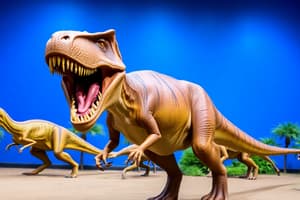Podcast
Questions and Answers
What is a Triceratops?
What is a Triceratops?
- A dinosaur known for its long tubular crest
- A giant sea turtle
- A large carnivorous bipedal dinosaur
- A dinosaur with three horns (correct)
What type of dinosaur is a Tyrannosaurus?
What type of dinosaur is a Tyrannosaurus?
large carnivorous bipedal dinosaur
What distinguishes a Parasaurolophus?
What distinguishes a Parasaurolophus?
It has a long tubular crest that makes a long low-frequency sound.
Identify what a gallimimus is known for.
Identify what a gallimimus is known for.
What is Archelon?
What is Archelon?
What is a Stegoceratops?
What is a Stegoceratops?
What does iguanadon refer to?
What does iguanadon refer to?
What is a mososaurus?
What is a mososaurus?
What animal is the term 'velociraptor' associated with?
What animal is the term 'velociraptor' associated with?
What is the function of the crest of a hadrosaurus?
What is the function of the crest of a hadrosaurus?
Flashcards
Tyrannosaurus
Tyrannosaurus
A large carnivore known for its massive teeth with knife-like serrations, capable of bipedal locomotion.
Parasaurolophus
Parasaurolophus
A hadrosaur recognizable by its long, tubular crest that produced low-frequency sounds.
Eoraptor
Eoraptor
An early dinosaur which is significant for understanding the evolution of later species.
Iguanodon
Iguanodon
Signup and view all the flashcards
Mosasaurus
Mosasaurus
Signup and view all the flashcards
Ankylosaurus
Ankylosaurus
Signup and view all the flashcards
Allosaurus
Allosaurus
Signup and view all the flashcards
Pentaceratops
Pentaceratops
Signup and view all the flashcards
Stegosaurus
Stegosaurus
Signup and view all the flashcards
Brachiosaurus
Brachiosaurus
Signup and view all the flashcards
Study Notes
Dinosaur Flashcards Overview
- Triceratops: Characterized by three prominent horns—two long above the eyes and one short on the nose.
- Tyrannosaurus: A large carnivore distinguished by massive teeth featuring knife-like serrations, capable of bipedal locomotion.
- Parasaurolophus: A hadrosaur noted for its long tubular crest, which produced low-frequency sounds.
- Gallimimus: Known for incredible speed, reaching up to 65 km/h, comparable to modern racehorses.
- Archelon: A colossal sea turtle from the Late Cretaceous, measuring 13.5 feet in length, found in Midwestern North America.
- Stegoceratops: A fictional hybrid dinosaur, created in the Jurassic World franchise.
- Eoraptor: An early dinosaur that is significant for understanding the evolution of later species.
- Iguanodon: One of the first dinosaurs to be named, notable for its distinctive thumb spikes used for defense.
- Mosasaurus: A large marine reptile, often confused with dinosaurs, thriving in prehistoric oceans.
- Indominus rex: A genetically engineered hybrid dinosaur from the Jurassic World series, noted for its massive size and predatory traits.
Additional Dinosaurs
- Ankylosaurus: A heavily armored dinosaur known for its club-like tail used for defense.
- Allosaurus: A large predatory dinosaur with sharp teeth and a powerful build, a formidable hunter of its time.
- Pentaceratops: A ceratopsian dinosaur with five facial horns and a large frill at the back of the head.
- Protoceratops: A small ceratopsian recognized for its parrot-like beak and frill.
- Styracosaurus: Features a unique array of long, curved horns on its frill, providing distinctive head ornamentation.
- Centrosaurus: Noted for its short, stout horns and a large bony frill, closely related to Styracosaurus.
- Smilodon: Often mistaken for a dinosaur, this saber-toothed cat is famous for its elongated canine teeth.
- Stegosaurus: Recognized for its distinctive back plates and spiked tail, which were likely used for defense and display.
- Brachiosaurus: Known for its long neck, enabling it to reach high vegetation, it was one of the tallest dinosaurs.
- Diplodocus: Featured a long neck and tail, this herbivore was among the longest dinosaurs known.
- Apatosaurus: Similar to Diplodocus, characterized by its long neck and heavy body, it was a massive herbivore.
- Velociraptor: A small but agile predator known for its speed and intelligence.
- Baryonyx: A carnivorous dinosaur known for its long claws and semi-aquatic lifestyle, possibly feeding on fish.
- Spinosaurus: Distinguished by its sail-like structure on its back, believed to have been a piscivore.
- Kentrosaurus: A smaller stegosaur equipped with spikes and plates for defense.
- Naustoceratops: A lesser-known ceratopsian distinguished by its unique head features.
- Lambeosaurus: Known for its distinctive crest, which may have been used for communication and display.
- Hadrosaurus: An important hadrosaur famous for its duck-bill and numerous fossils that provide insight into dinosaur behavior.
- Pachyrhinosaurus: Characterized by its thickened nasal region and frill, making it unique among ceratopsians.
Studying That Suits You
Use AI to generate personalized quizzes and flashcards to suit your learning preferences.




